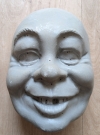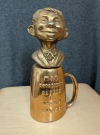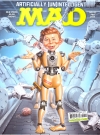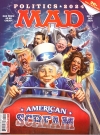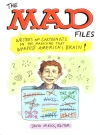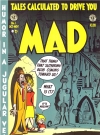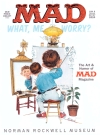The following article was originally published in Dynamite Magazine Number 3 from 1974. Reprinted with permission from Scholastic Inc.
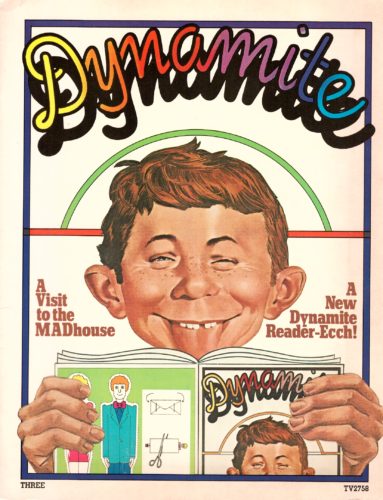
A visit to the MADhouse
The publisher of Mad, William M. Gaines, has King Kong’s head staring in through his office window. Miniature zeppelins hang from the ceiling and a human skull sits on his shelf, clearly, the home of a MAD person. When Gaines entered, he looked as wild as his office. His long gray hair was parted clown the middle and his overweight body was Wrapped in dumpy clothes. lt seemed that it would take a crazy man like this to put out America’s top humor magazine with 2.5 million readers.
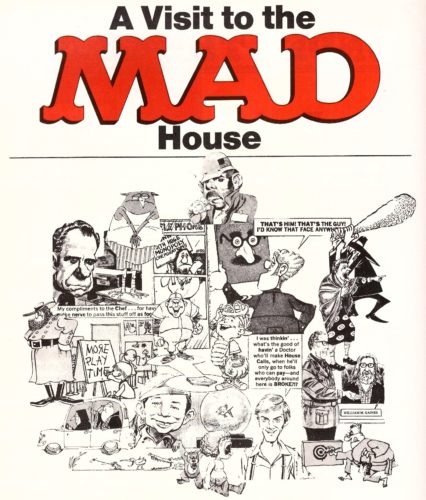
Not knowing what to expect, we asked Gaines what kind ot influence MAD had on kids. To our surprise, he began speaking in a calm, serious voice.
“If we accomplish anything, it’s giving youngsters a healthy cynicism at an early age. Kids today absorb a tremendous amount of knowledge from TV, but they also absorb a lot of false values and a lot of nonsense from commercials. MAD tries to counteract this.”
Later, we went down the hall to talk to Len Brenner, MAD’s production manager who’s known there as “Mr. Hostility.”
“I don’t want to talk about MAD,” he said, “I don’t read it. It’s a personal prejudice. I hate everyone here.” But as soon as we turned off the tape recorder, Len suddenly became a friendly guy and asked us all about DYNAMITE. “Mr. Hostility”? Was it just an act? And which was the real Gaines, the King Kong Crazy or the perceptive publisher? And what about…
Alfred E.?
We had to ask Gaines what the story was. Is the MAD staff the gang of idiots it pretends to be?
“You really can’t be insane when you’re working,” Gaines admitted, “Sometimes we don’t have time to be crazy.”
If there’s one thing the MAD men take seriously, it’s their humor. A lot of time goes into each MAD parody. And there’s a message in every one. Parodies can be funny just because they copy something – like a movie or a song – and make humorous changes. But MADs parodies try to point out phoniness and false values as well. For instance, when MAD parodied Camel cigarettes, they were called “Cancel” cigarettes, with the idea that smoking would cancel your life.
MAD editor Al Feldstein explained that parodies like Wacky Packs were not up to MAD level. “They’re MAD-like,” he said, “But some of the stuff is just parody without any point. MAD would have tried to make a point. We help our readers think clearly about the kind of junk that’s handed to them.”
But when MAD first started, it didn’t have ideas like these. MAD was created in the early 1950’s by E. C. Publications, a company that published war and horror comic books. To get away from all that violence and gore, the staff of E. C. decided to put together a comic just for fun, just to entertain themselves. They thought it was a mad thing to do, so they called their project MAD Comics.
The first issues of MAD looked like any other comic books. But inside they poked fun at the comic world with parodies like “Superduperman” and “Batboy and Rubin.” Though MAD had a loyal following, E. C.’s horror and war comics were still the big sellers. However, in 1954, the Comics Code Authority banned them, claiming they rotted young minds. The only
thing E. C. had left was MAD. They changed it to magazine size so that it wouldn’t have to follow the Comics Code, and MAD Magazine was born.
MAD had been going for several years before its famous cover boy, Alfred E. Neuman, became a part of the magazine. There is some mystery about the origin of this moronic mug. At one time, MAD was sued by a woman who claimed that her husband had created Alfred in 1914. But MAD won the case and saved the face after it found earlier pictures of Alfred. His creator is still in question, but it’s believed that the first version of Alfred’s face was on a dental poster from around 1900. It showed Alfred grinning and pointing to the gap in his teeth saying, “What~me worry?”—meaning, this dentist was so painless you didn’t have to worry about having a tooth pulled. Wherever the face came from, it was MAD who gave the boy his name.
Besides the Alfred case, MAD had other problems getting started. “In the beginning,” Al Feldstein told us, “We had trouble getting photographs from the movie companies for our artists to look at. We’d call up and say, ‘This is MAD Magazine… ‘ and klunk!—they’d hang up. But now, when we call a movie company and say we’d like to parody one of their pictures, they send us a package of photos right away.”
It’s still a difficult job to put together 48 pages of humor every month. The MAD staff goes to movies together to get ideas for parodies and, still, sometimes they’re hard to come by.
MAD also gets a huge amount of mail from people who have ideas for stories. Every one is read and considered.
When a MAD writer dreams up an idea, he’ll come in and talk to the editors about it. Associate editor Jerry de Fuccio told us how these meetings go:
“A writer will say to us something like ‘Detroit has been recalling cars for readjustments. We wouldn’t be surprised if . . .’ Then he gives us examples of recalls in other areas. For instance, he’ll say ‘Suppose the whole graduating class of a medical school was called back because they found out that one professor was teaching a wrong technique.‘ Then we’ll all add our ideas to his and try to make a story.”
If the story’s accepted, it’s given to an artist to illustrate. Al Feldstein arranges the words inside the balloons and fits them all together on the page like a jigsaw puzzle. It takes a lot of patience to do these interlocking ballons that MAD is famous for.
A little insanity goes a long way in the MAD offices, and there are plenty of occasions for the staff to act like “the usual gang of idiots.” They yell insults down the halls at each other during the day. The MAD artists sneak pictures of themselves and their bosses into the magazine. And every year, publisher Gaines takes the whole staff on a vacation to some foreign country where they can release their craziness on the unsuspecting natives.
But the funny business stops when the business of being funny begins. It’s the care and seriousness the MAD gang puts into their magazine that lets Alfred keep grinning at the world “What—me worry?”





